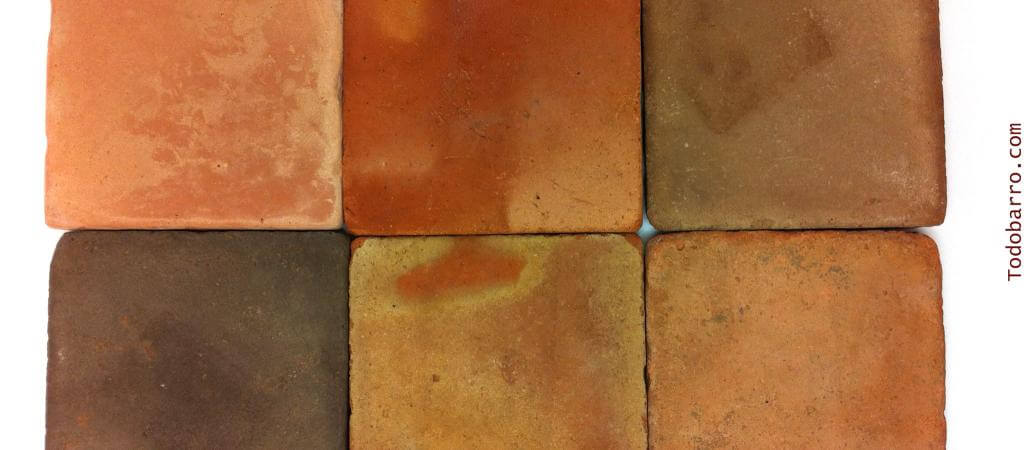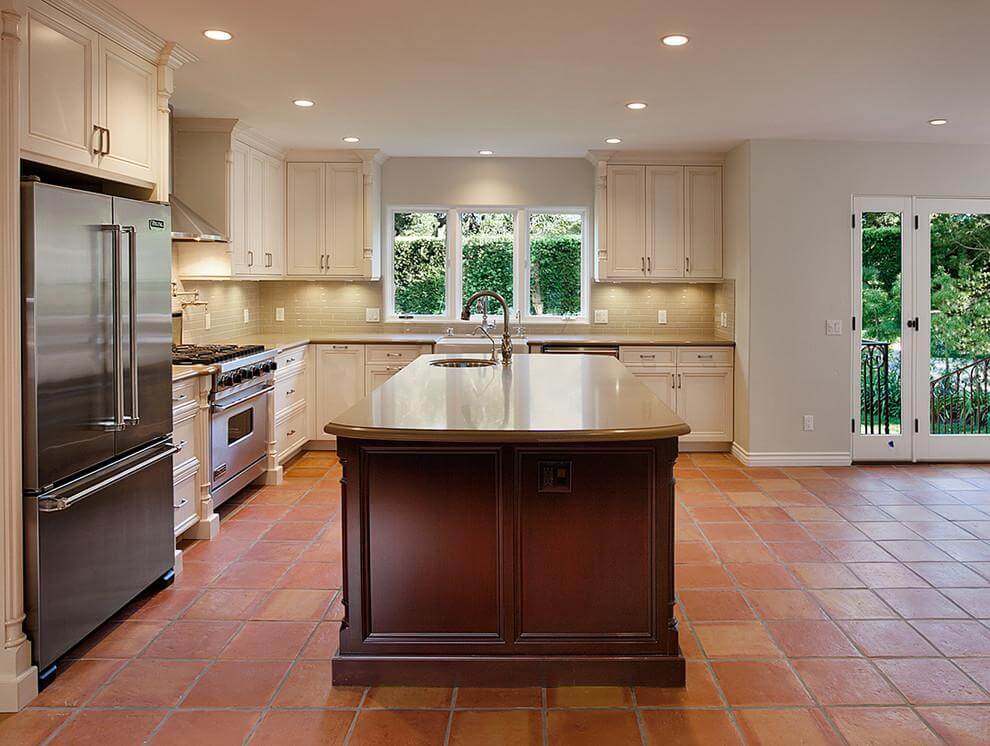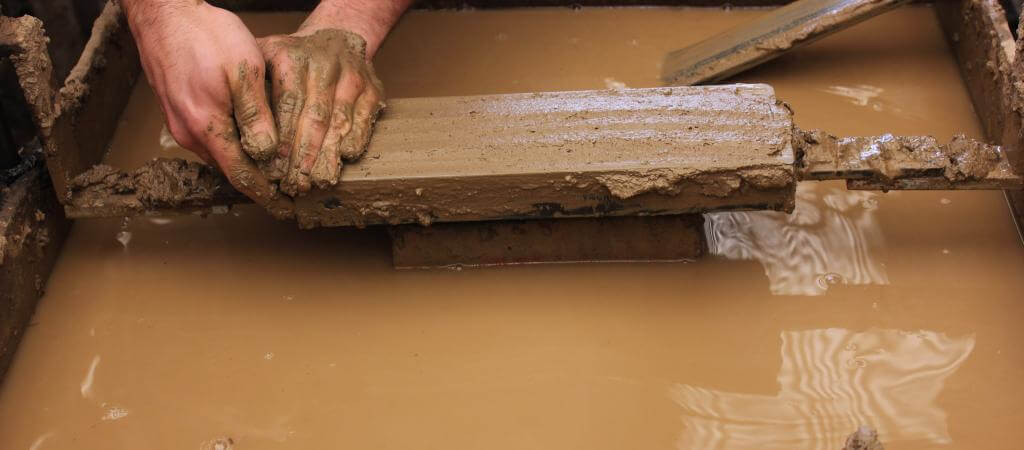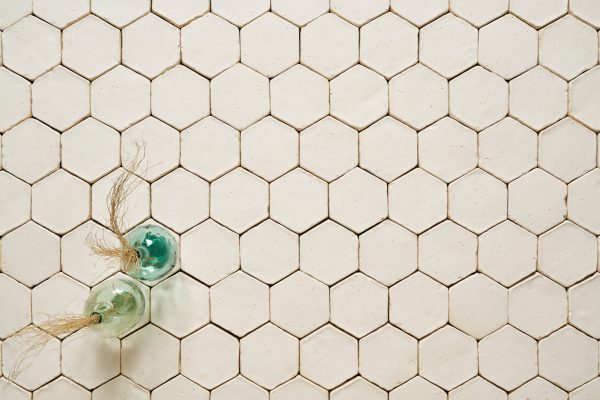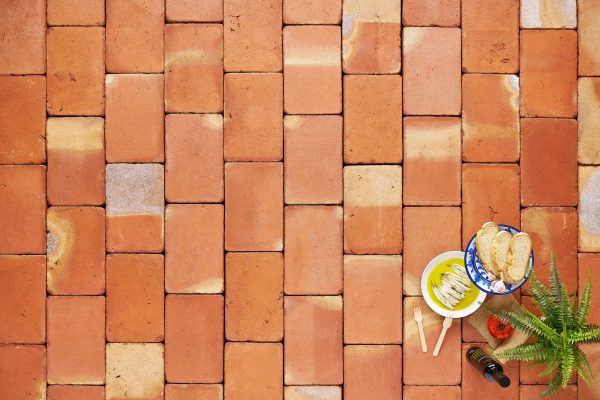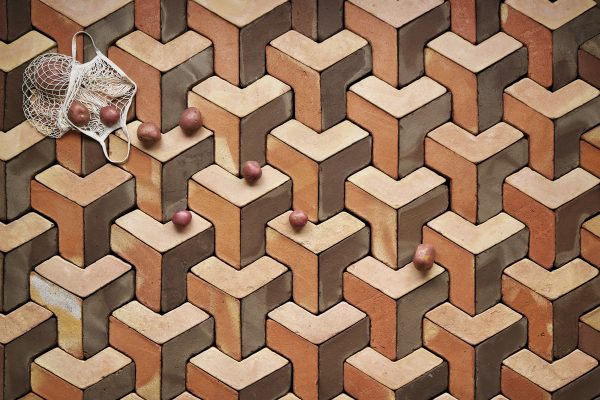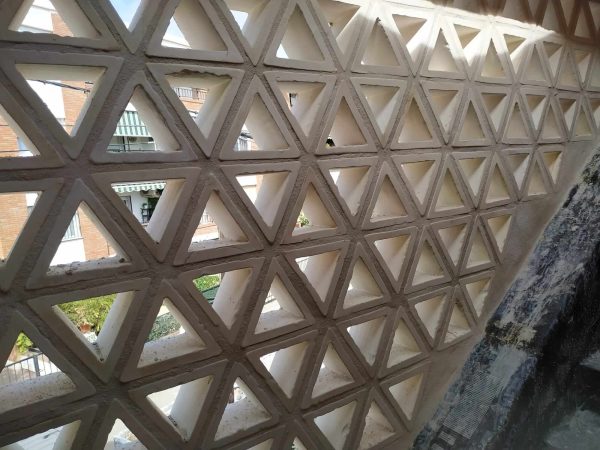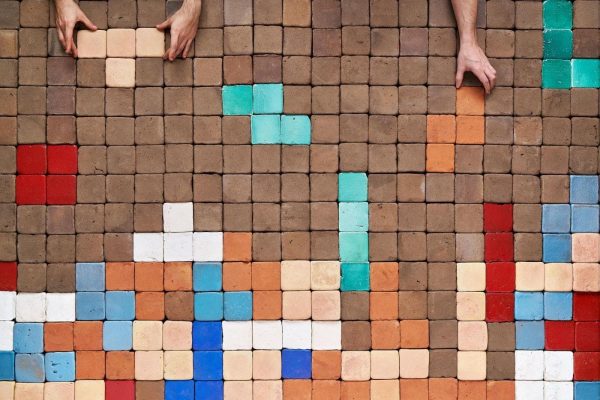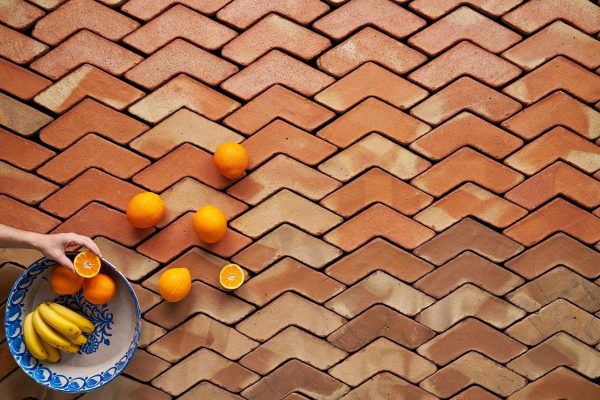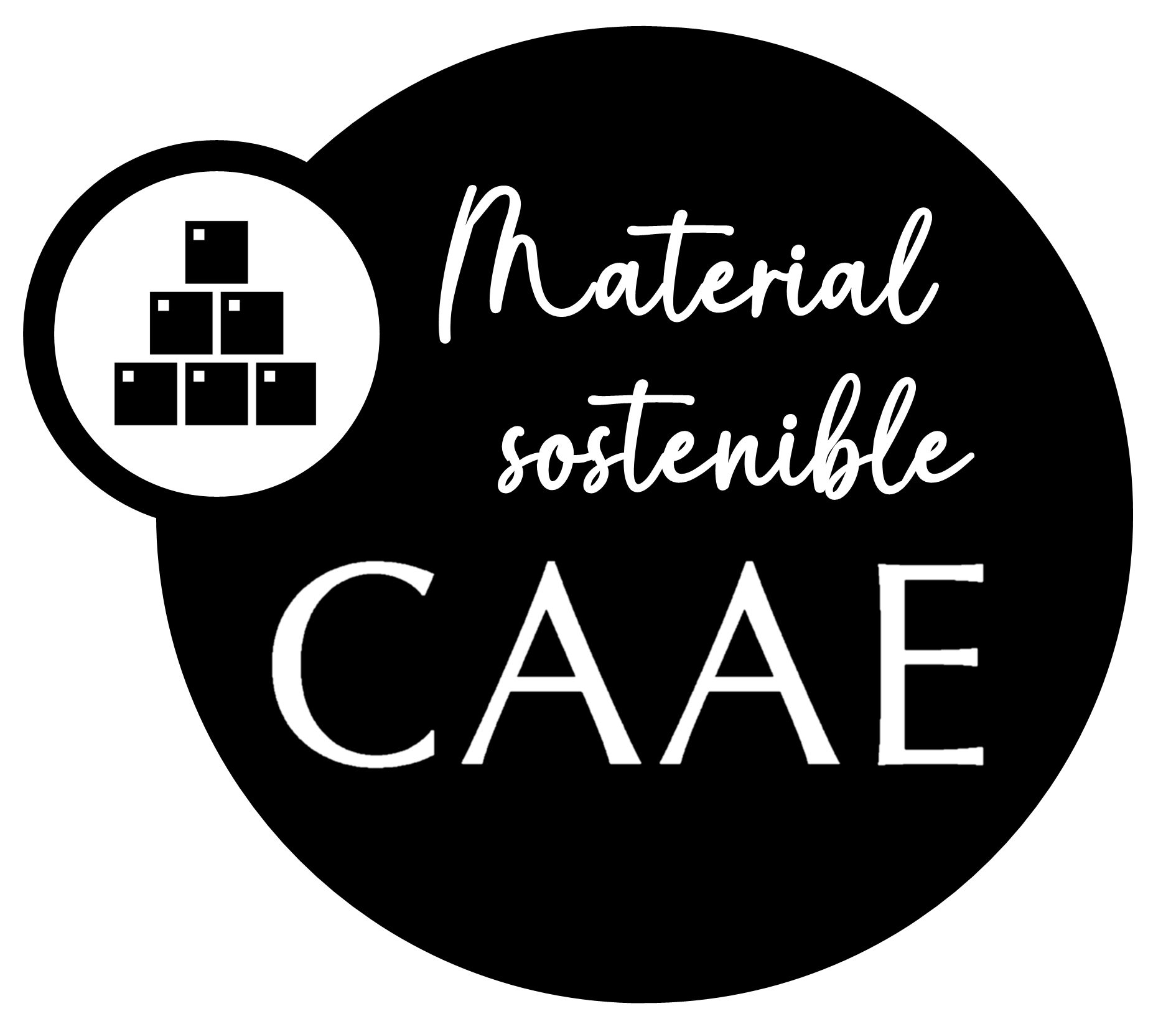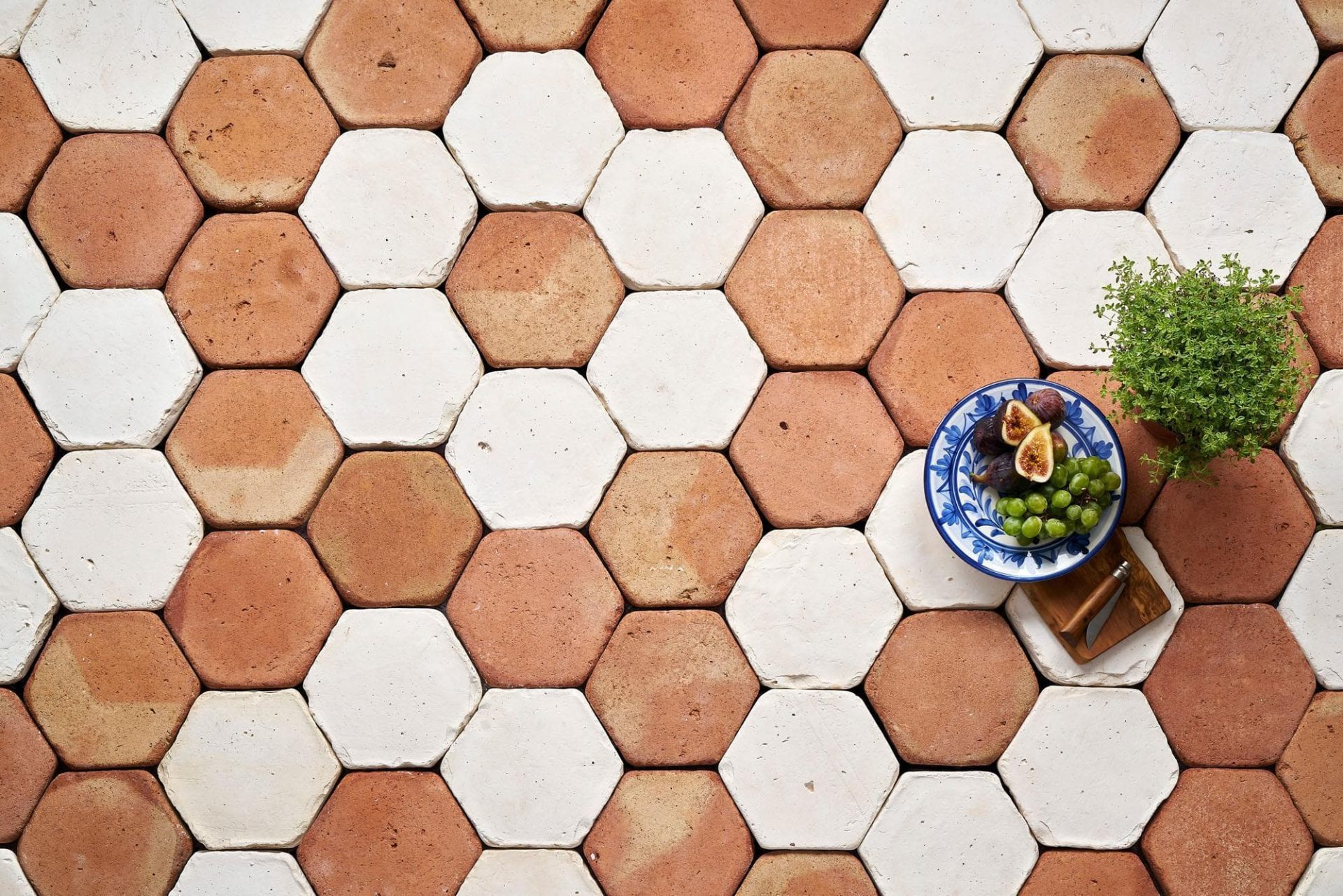
Fired clay or terracotta tiles
Handmade fired clay or terracotta tiles are a type of ceramic tiles that have a rustic appearance of non-uniform earthy color.
Handmade fired clay or terracotta tiles are a type of ceramic tiles that have a rustic appearance of non-uniform, earthy color. The tonality depends mainly on the clays that compose it and the firing.
1) Denomination and use
Terracotta tiles is a term commonly applied to a great variety of pieces with very different characteristics that coincide in their rustic appearance, high capacity for absorbing water, and the non-application of glazes.
The production is limited, discontinuous and scattered, generally shaped plastically under artisanal techniques and subjected to a single cooking process. Their characteristics make them special and suitable for new buildings, renovations or premises that seek a rustic vibe.
2) Body and shades of fired clay or terracotta tiles
A fired clay tile’s body is of earthy and non-uniform color, with a very irregular texture and easily visible grains, pores and incrustations.
The sides and edges have marked irregularities that are assumed to be typical of these products, so wide-joint tile installation is recommended. There is a wide variety of shapes and sizes.
The coloration and shades vary depending on the selected clays and the cooking process, so it is recommended to check the clay tiles before laying them down and to mix them during the installation process.
The main shades present in the clays of our national territory are reddish, salmon and straw-flamed. Other colors that are beginning to be introduced in the sector are slate and varieties of leather (antique and reddish).
3) Technical characteristics of terracotta tiles
Due to the high presence of pores and capillaries, it should be foreseen that this type of ceramic tiles requires the treatment of the up surface with waxes or “ad hoc” applied products, before or after tile installation, for reasons of appearance (gloss) or functional (stain rejection, resistance to cleaning products, waterproofing).
Likewise, it is not recommended for installation on exterior floors with a high risk of frost, unless the technical specifications of the tiles recommend it.
Terracotta tiles are, for the most part, included in groups AIIb UGL (extruded ceramic tiles with water absorption 6%<E≤10%) and AIII, UGL (extruded ceramic tiles with water absorption E<10%) of standards ISO 13006 and EN-UNE 14411, Annexes E or F.
| Usual sizes | Usual thickness | Water absorption | Breaking strength |
|---|---|---|---|
| High dispersion | > 10 mm. | 6-15% | 2300 – 3200 N |
| Abrasion Gl | Abrasion UGL | Frost resistance | Chemical resistance |
| Variable | 300 – 800 mm3 | None | Variable |
4) Definition and classification of ceramic tiles
Al-Andalus, the part of the Iberian Peninsula inhabited by Arabs and Muslims (8th through 15th Centuries), was the route by which ceramic glazing techniques reached the West.
The history of Spanish ceramic tiles begins at the end of the 13th century with Muslim tiling and continues up to the present day; during this time, tiles in the Gothic-Mudejar, Baroque and Modernist styles are particularly brilliant.
Until a few years ago, however, fired clay tiles and floor tiles were of limited array, and knowledge of their qualities and possible uses was part of the common heritage.
But the diversification of production that has accompanied the growth and technological progress, which has made it possible to achieve finer characteristics and, therefore, new uses, have made this body of knowledge difficult to handle, even for professionals, who find their desks overrun with information on these and many other materials and techniques.
This new situation has given rise to a lack of terminology that makes consensus difficult and is a source of confusion. Thus, it is common to hear or even read in advertising, terms and conditions texts, or work specifications words or phrases of dubious, indefinite or redundant meaning, such as “stoneware”, “ceramic flooring” or “glazed tiles”.
In order to help those users interested in deepening their knowledge of this type of ceramic tiles and pavements, we have incorporated to our section some chapters of the “Guide of the ceramic tile”. This manual aims to recover the knowledge of ceramic tiles, traditional or new, and to order the terminology starting from the most accepted or acceptable.
Classification of ceramic tiles according to regulations
Ceramic tiles are thin slabs, generally used for floor and wall coverings, manufactured from a mix of clays and other inorganic raw materials, which undergo grinding and/or kneading, are molded and then dried and fired at a temperature high enough for them to acquire the required properties in a stable manner.
According to the aforementioned standards, the basic classification of fired clay tiles results from the method used for shaping and water absorption. The surface finish provides further classification criteria.
| Water absorption | |||||
|---|---|---|---|---|---|
| Tipe of molding | Group Ia / E ≤ 0.5% | Group Ib / 0.5%‹E≤3% | Group IIa / 3%‹E≤6% | Group IIb / 6%‹E≤10% | Group III / E>10% |
| Extruded tiles | Group AIa / Very low | Group AIb / Low | Group AIIa / Medium-low | Group AIIb / Medium-high | Group III / High |
| Dry pressed tiles | Group BIa / Very low | Group BIb / Low | Group BIIa / Medium-low | Grupo BIIb / Medium-high | Grupo III / High |
4.1) Groups of fired clay tiles by type of shaping
Tiles can be extruded or dry pressed. Extruded tiles form group A of the standards and dry-pressed tiles form group B.
The type of molding can generally be identified by observation of the tile, particularly of the texture on its back face. The bumps or grooves on the surface, commonly called “ribs”, increase the contact surface with the adhesive and therefore the adhesion of the tiles once laid.
- The texture of the extruded tiles has the form of parallel longitudinal grooves, more or less pronounced, the tile retaining the same cross-section along the direction of the grooves. It does not generally include the factory stamp, although in some cases it is engraved on the edges.
- The surface of dry pressed tiles is distributed without a preferred direction, and has dots or lines arranged in the form of a grid, honeycomb or other design, that can be even decorative. Sometimes it imitates the grooving of extruded tiles. It often includes the brand name and some sign of production control.
4.2) Groups of ceramic tiles classified according to water absorption
The porosity of terracotta tiles is expressed by the percentage of water absorption in relation to the total weight of the tile, measured according to a standardized test. Porosity is closely related to some of the other characteristics of ceramic tiles.
- Types: water absorption up to 3 % is considered low (group I) and within this, up to 0.5 % very low (group Ia). Between 3 and 6 %, it is considered medium-low (group IIa) and between 6 and 10 % medium-high (group IIb). Above 10 % absorption is considered high (group III).
- Recon: a quick system to know approximately the water absorption and thus identify the group and type of product, is to observe the suction speed of the tile. To do this, place a drop of water on a clean, unglazed face at room temperature (between 15º and 25º C), wait 20 seconds and observe the result:
- If the substrate sucks the water in less than 20 seconds, it is porous tile, group III.
- If the substrate does not suck up the water completely in 20 seconds and there remains a humidity stain after drying the drop with a cloth, it is a slightly porous tile, group IIb.
- If the substrate does not suction the water in 20 seconds and no humidity stain remains after drying the drop with a cloth, it is a non-porous tile, of groups IIa or I.
4.3) Types of fired clay or terracotta tile surface finishes
- Glaze: this is a vitrified covering that is fired and strongly adhered to the upper face of the body or substrate of glazed tiles (GL). It has a different composition from that of the body, and is applied between a first and a second firing (double firing process), or before a single firing (single firing process). The exposed face thus acquires the appearance and properties of the glaze, which can be very different from those of the support. In general, the glaze is easily distinguished with the naked eye or, at least, by observing a section of the tile. Tiles that do not have a glaze layer or unglazed tiles (UGL) are produced by subjecting the body, after molding, to a single firing. The faces are of the same nature and appearance as the body.
- Engobe: is a plaster of clay or light paste with which the exposed face of the tile is covered to cover its darker color. Although a glaze is generally applied over the engobe, it can be left as a surface finish, which, after firing, is matte and less impermeable and harder than the glaze.
- Polished: is a treatment that smoothes and gives a reflective shine to the face. It is usual in porcelain stoneware tiles and has started to be used in a small amount of stoneware tiles and paving.
4.5) Most common types of ceramic tiles and their characteristics
The ceramic tiles most commonly used in Spain are described below, using the most widespread designations and taking into account objective criteria of a technical, tariff or other nature. However, it should be borne in mind that these names are not standardized, nor are they accepted or understood in the same way, so that it may be necessary to make clarifications to avoid misunderstandings, particularly in cases where this is noted.
| Tipes of tiles | Moulding | Support | Glaze | Measurements (cm) | Thickness (mm) | ISO 13600 UNE 67-087 |
| Glazed tiles | Pressed | Porous | Yes | 10×10 a 45×60 | <10 | BIII |
| Stoneware tiles | Pressed | Non-porous | Yes | 10×10 a 60×60 | >8 | BIb – BIIa |
| Porcelain stoneware | Pressed | Non-porous | No | 15×15 a 60×60 | >8 | BIa |
| Baldosín catalán | Extruded | Porous or slightly porous | No | 13×13 a 24×40 | <8 | AIIb-AIII |
| Rustic stoneware | Extruded | Non porous | No-Yes | 11.5×11.5 a 37×37 | >10 | AI-AIIa |
| Terracotta | Extruded | Porous | No | Big range | >10 | AIIb 2ª-AIII |
